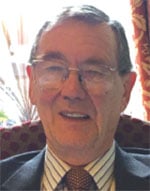MICHAEL R. HAMBLIN, WELLMAN CENTER FOR PHOTOMEDICINE
For decades, those who worried about their health were chiefly concerned about developing cancer or suddenly
suffering a heart attack. How this has changed!
In the 21st century, what concerns folks most is the fear of losing their faculties, with memory loss, dementia, and Alzheimer’s disease at the top of the list. The numbers affected by these disorders are growing so rapidly that the word “epidemic” is frequently used. The brain is now the organ people worry about most. Unfortunately, even cutting-edge modern medicine has little to offer when it comes to effective and safe pharmaceutical treatments for brain disorders.
Not only are neurodegenerative diseases affecting millions, but brain damage resulting from strokes, chronic head injuries, and heart attacks is also wreaking havoc. Moreover, a wide range of psychiatric disorders (depression, anxiety, addiction, and PTSD) and neurodevelopmental conditions (autism and ADHD) are affecting millions of people.
What if all of these brain disorders could be treated by something as simple as shining an NIR light on the head? Although this may at first seem to be a fantasy, the idea may be worth investigating. Photobiomodulation (PBM), formerly known as low-level laser therapy (LLLT), was discovered over 50 years ago by Endre Mester in Hungary.
For a long time, PBM was used mainly to help with pain, inflammation, and wound healing. Laser therapists used fairly low-power red lasers (e.g., HeNe or 660 nm) and treated areas of the body using focused points of light from a laser. The mechanism of action was mainly (but not completely) elucidated by Tiina Karu in Russia. Much is now understood about the effects of wavelength, power density, and total energy on the outcomes of treatment for different disorders.
The most important of the photoreceptors is cytochrome c oxidase subunit IV in the mitochondrial respiratory chain. Adenosine triphosphate (ATP) is increased, and signaling pathways and transcription factors are activated. A single exposure to light in some models can have beneficial effects up to four weeks later.
In part, what prompted the change from the somewhat old-fashioned LLLT or laser therapy to the modern-day PBM was the introduction of relatively high-power LED arrays. Previously, a therapeutic laser might have had a total power of 500 mW, but now LED arrays can have powers of tens of watts, do not have any safety issues, and are entirely suitable for home use.
Another big step forward was the availability of different NIR wavelengths (830, 850, 880, and 940 nm). Both red and NIR light are effective, but NIR penetrates deeper into tissue. Now, there are several companies designing light-emitting
helmets to treat all sorts of brain disorders and whole-body “light beds” for improving athletic performance, general health, and wellness.
The question is often asked, “Does the NIR light really penetrate the hair, scalp, and skull to reach the brain?” The answer is that although some light will definitely reach the cortex, it is entirely possible that light is absorbed by other tissues (skin, blood, and skull) and can exert an abscopal effect on brain function via blood circulation or nerves.
Dramatic improvements can sometimes be seen after only a few applications of NIR light to the head (when treating acute head injuries and strokes, for example), using dose regimens in the region of 20 J/cm2 over an area of 1000 cm2 (total energy 20 kJ) delivered for 20 minutes twice a week. But it is possible that for some conditions, such as Alzheimer’s and Parkinson’s diseases, treatment may be needed indefinitely.
In some cases, the brain’s ability to heal itself (neurogenesis and neuroplasticity) can be triggered by NIR light, perhaps producing long-lasting improvement. Disorders such as PTSD and addiction, which are characterized by abnormal connections formed within the brain, may also benefit from PBM.
The clinical trials (often on a small pilot scale) conducted so far have shown remarkable success in treating Alzheimer’s disease, dementia, chronic traumatic brain injury, ischemic stroke, major depression, and anxiety. There also are anecdotal reports of its benefits in other brain disorders.
However, one intriguing question remains largely unanswered: Does PBM work on normal, healthy individuals to produce cognitive enhancement? Some small-scale studies suggest it does, and the ELECTRA trial is now underway at Massachusetts General Hospital in hopes of providing a definitive answer.
To achieve the full potential of PBM, we will need to better understand the mechanisms, convince a skeptical medical community that doesn’t believe light alone can have a positive effect, and overcome competition from big pharma companies that will be reluctant to lose their market dominance. However, the potential rewards for patients and society at large make the efforts worthwhile.
 Meet the author
Meet the author
Michael R. Hamblin, Ph.D., is a principal investigator at the Wellman Center for Photomedicine at Massachusetts General Hospital and an associate professor of dermatology at Harvard Medical School. He has published 420 peer-reviewed articles and is editor in chief of the newly renamed Photobiomodulation, Photomedicine, and Laser Surgery, and he is associate editor for 10 other journals. Hamblin also works on National Institutes of Health Study Sections and has authored and edited 23 textbooks on photodynamic therapy and photomedicine — and co-edited issues of Proceedings of SPIE. He is a fellow of SPIE and has received the Endre Mester Lifetime Achievement Award in Photomedicine from the North American Association for Photobiomodulation Therapy, and the Outstanding Career Award from the International Dose-Response Society.